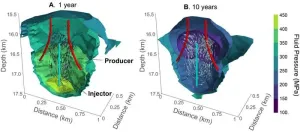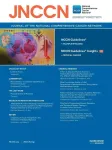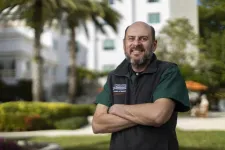(Press-News.org) Conference indicates surging interest in superhot, superdeep geothermal energy
--Renewable resource has potential to revolutionize our energy system
For Immediate Release: December 11, 2023
By Elizabeth A. Thomson for Quaise Energy
For more information, including technical papers and graphic, please contact Elizabeth Thomson, 22elizabeththomson@gmail.com.
CAMBRIDGE, Mass.--In an indication of growing interest in the holy grail of geothermal energy—tapping into the superhot rock miles below our feet—18 papers on the topic were presented over multiple sessions at a recent major conference on the overall geothermal industry.
“By driving down costs and making large-scale geothermal power available nearly anywhere, Superhot Rock energy has the potential to disrupt and revolutionize the energy system.” That’s according to a description of the sessions on Technological, Engineering, and Geological Advances in Superhot Geothermal presented at the 2023 Geothermal Rising Conference held over four days in October.
“For me, a pretty big highlight of Geothermal Rising 2023 was the increased focus on superhot rock geothermal through multiple presentations from around the world,” says Matt Houde, co-founder and project manager at Quaise Energy.
Houde is a co-author of two papers presented at the conference. Both report on research showing that superhot geothermal “can be viable,” he says. One of the papers describes work led by researchers from Europe on the first computer simulations of a Superhot Enhanced Geothermal System (EGS) reservoir capable of plumbing the energy from more than six miles (10-20 km) down where rocks can reach temperatures of more than 752 degrees Fahrenheit (400oC).
The other paper describes work led by researchers at TEVERRA, LLC, on the stability of a geothermal well extending miles into the Earth, where superhot temperatures are abundant. It addresses some of the challenges associated with drilling and producing geothermal energy at such depths.
Houde emphasized that although both papers “validate some of our assumptions on the potential of a superhot reservoir,” additional research is necessary. “We need more experimental data to fully determine the viability of the resource.”
Other papers on superhot rock presented at the conference addressed everything from the resource’s potential in New Zealand to a review of the Iceland Deep Drilling Project. The full superhot agenda, including titles of the papers, can be seen at the following links: Session 4C, Session 5B, and Session 6D.
The Energy Down Deep
The mother lode of geothermal energy is some 2 to 12 miles beneath the Earth’s surface where the rock is so hot that if water could be pumped to the area it would become supercritical, a steam-like phase that most people aren’t familiar with. (Familiar phases are liquid water, ice, and the vapor that makes clouds.) Supercritical water, in turn, can carry some 5-10 times more energy than regular hot water, making it an extremely efficient energy source if it could be pumped above ground to turbines that could convert it into electricity.
Today we can’t access those resources. The number one problem: we can’t drill down far enough. The drills used by the oil and gas industries can’t withstand the formidable temperatures and pressures that are found miles down without becoming exponentially more expensive with depth.
Quaise is working to replace the conventional drill bits that mechanically break up the rock with millimeter wave energy (cousins to the microwaves many of us cook with). Those millimeter waves literally melt then vaporize the rock to create ever deeper holes.
As the company develops the technology, it is also funding basic research to give a better understanding of the dynamics and conditions associated with tapping the heat deep below our feet. Says Carlos Araque, CEO of Quaise, “We don’t want to just blindly drill a hole and hope for the best. We want to make sure that we’re using the best human knowledge and understanding to know what to expect.”
First Simulations
The paper on the first simulations of heat mining at 10-25 km depths was presented by its first author, Samuel Scott of the Institute of Earth Sciences at the University of Iceland. Additional authors, in addition to Houde, were Alina Yapparova of the Institute of Geochemistry and Petrology at ETH Zurich, and Philipp Weis of the GFZ Potsdam German Research Center for Geosciences.
While Scott’s presentation was limited in scope because the paper is currently under review by a scientific journal, he described the basic functionality of the models behind the simulations and a few results.
For example, he said, “our models show that superhot rock enhanced geothermal systems can achieve high power output with a small spatial footprint,” or amount of land needed atop the hole. More specifically, he said, “we found that hypothetical systems involving a well doublet or triplet can deliver a thermal power output of >100-120 MW per well for timescales of decades.” That’s 5-10 times more power than typically produced today from a conventional, shallower geothermal system, Houde says, and this improvement in power density could make geothermal competitive with oil and gas.
Scott notes that these results depend on the model assumptions, particularly the effectiveness of hydraulic stimulation at such depths. As a result, he and colleagues are continuing research to refine the models with more data and constraints on rock behavior. They are focusing on three key parameters: water flow within the holes, or wellbores; the chemical reactions expected to occur in the reservoir; and rock mechanics and fractures at these depths and temperatures.
Wellbore Stability
The paper on wellbore stability was presented by Jerjes Porlles of TEVERRA, LLC. His coauthors, in addition to Houde, are Andrew Madyarov, Joseph Batir, and Hamed Soroush, all of TEVERRA.
Specifically, Porlles and colleagues explored the stability of a wellbore at the depths that Quaise is targeting for superhot rock geothermal energy production. Says Porlles, “in this paper, we explored some of the dynamics behind fluid flow and cool water – rock interactions in a hypothetical borehole, and none of the models show borehole stability issues.” That said, he emphasized the need for additional data on, for example, rock type and associated material properties, and further testing on the material properties developed during the millimeter wave drilling process” being developed by Quaise.
The work on both of these papers was supported by Quaise Energy.
============
Written by Elizabeth Thomson, correspondent for Quaise Energy.
END
Conference indicates surging interest in superhot, superdeep geothermal energy
Renewable resource has potential to revolutionize our energy system
2023-12-11
ELSE PRESS RELEASES FROM THIS DATE:
UM School of Medicine awarded nearly $30 Million to improve health outcomes of IV drug users
2023-12-11
University of Maryland School of Medicine (UMSOM) Dean Mark T. Gladwin, MD, announced today that the school will receive a $29 million research award over four years from the National Institutes of Health to lead a multicenter trial that aims to improve health outcomes in people who inject opioid drugs and are hospitalized with infectious complications of their drug use. Faculty affiliated with the Institute of Human Virology and the Kahlert Institute for Addiction Medicine at UMSOM will be conducting the research.
The research award, which has provided ...
Risk factors for long-term arm morbidities following breast cancer treatments: A systematic review
2023-12-11
“This review revealed 29 primary risk factors associated with arm morbidity after breast cancer treatment.”
BUFFALO, NY- December 11, 2023 – A new review paper was published in Oncotarget's Volume 14 on December 1, 2023, entitled, “Risk factors for long-term arm morbidities following breast cancer treatments: A systematic review.”
In this review, researchers Ifat Klein, Michael Friger, Merav Ben David, and Danit Shahar from Assuta Medical Center and Ben-Gurion University of the Negev in Israel ...
Clues to preventing Alzheimer’s come from patient who, despite genetics, evaded disease
2023-12-11
Alzheimer’s disease has plagued one large Colombian family for generations, striking down half of its members in the prime of life. But one member of that family evaded what had seemed would be fate: Despite inheriting the genetic defect that caused her relatives to develop dementia in their 40s, she stayed cognitively healthy into her 70s.
Researchers at Washington University School of Medicine in St. Louis now think they know why. A previous study had reported that, unlike her relatives, the woman carried ...
Hungarian scientists prove that senescence can accelerate evolution
2023-12-11
The mystery of aging has fascinated people for millennia, with many willing to do anything to halt or reverse this process, because aging is typically associated with gradual deterioration of most body functions. While senescence is a natural part of life, biologists understand surprisingly little about the emergence of this process during evolution. It is not clear whether aging is inevitable, because there are organisms that seemingly do not age at all, moreover, the phenomenon known as negative aging, or rejuvenation, does exist: some turtles’ vital functions improve ...
Real world data shows impact of immunotherapy in populations underrepresented in clinical trials, according to JNCCN study
2023-12-11
PLYMOUTH MEETING, PA [December 11, 2023] — New research in the December 2023 issue of JNCCN—Journal of the National Comprehensive Cancer Network finds patients treated with first-line immunotherapy for advanced Non-Small Cell Lung Cancer (NSCLC) showed similar results in terms of survival, progression-free survival, and treatment duration, regardless of race or ethnicity, even with differences in income and insurance. The clinical investigators focused on patients in under-represented groups who were typically less likely to be included in the immunotherapy clinical trials that have been conducted ...
Research by Sylvester, collaborators leads to new treatment options for advanced myelofibrosis, other blood malignancies
2023-12-11
DOWNLOADABLE VIDEO
MIAMI, FLORIDA (EMBARGOED UNTIL MONDAY, DEC. 11, 2023, AT 2:45 P.M. ET) – Few standard treatments have been available for advanced myelofibrosis, a bone marrow disorder characterized by excessive scar tissue that disrupts the normal production of blood cells
But new research conducted by investigators at Sylvester Comprehensive Cancer Center at the University of Miami Miller School of Medicine and collaborating cancer centers indicates that a new type of targeted therapy may ...
A new mechanism by which rotavirus makes you sick
2023-12-11
Rotavirus causes gastroenteritis, a condition that includes diarrhea, deficient nutrient absorption and weight loss. Severe cases result in approximately 128,000 deaths annually in infants and children worldwide. Despite intense research on how rotavirus causes diarrhea, there is still no complete answer, but in this new study researchers at Baylor College of Medicine report a new mechanism by which rotavirus induces diarrhea, interfering with the normal absorption of nutrients in the intestine.
The study, published in Proceedings of the National Academy of Sciences, is the first to show that rotavirus-altered lipid metabolism in the intestine plays a ...
Portable, non-invasive, mind-reading AI turns thoughts into text
2023-12-11
In a world-first, researchers from the GrapheneX-UTS Human-centric Artificial Intelligence Centre at the University of Technology Sydney (UTS) have developed a portable, non-invasive system that can decode silent thoughts and turn them into text.
The technology could aid communication for people who are unable to speak due to illness or injury, including stroke or paralysis. It could also enable seamless communication between humans and machines, such as the operation of a bionic arm or robot.
The ...
Tirzepatide enhances weight loss with sustained treatment but discontinuation leads to weight regain
2023-12-11
Tirzepatide Enhances Weight Loss with Sustained Treatment but Discontinuation Leads to Weight Regain
The current class of anti-obesity drugs is proving remarkably effective at removing excess pounds. However, a phase 3 randomized clinical trial led by researchers at Weill Cornell Medicine and NewYork-Presbyterian found that people who stopped taking the medication regained much of that weight within a year. At the same time, the study shows that remaining on the drug not only promotes additional weight loss but preserves improvements in metabolic and cardiovascular health.
The results from the SURMOUNT-4 study, which appeared Dec. ...
Scholars named for research leadership program to increase diversity in clinical trials
2023-12-11
DALLAS, Dec. 11, 2023 — The American Heart Association — the world’s leading voluntary organization dedicated to a world of longer, healthier lives for all — continues its commitment to address the lack of diversity, equity and inclusion in clinical trials for medical research with the selection of two early-career scientists for the inaugural Robert A. Winn Clinical Investigator Leadership Award in Cardiovascular Research (Winn CILA-CV). The award is sponsored by the Bristol Myers ...
LAST 30 PRESS RELEASES:
Ticking time bomb: Some farmers report as many as 70 tick encounters over a 6-month period
Turning garden and crop waste into plastics
Scientists discover ‘platypus galaxies’ in the early universe
Seeing thyroid cancer in a new light: when AI meets label-free imaging in the operating room
Neutrophil-to-lymphocyte ratio may aid risk stratification in depressive disorder
2026 Seismological Society of America Annual Meeting
AI-powered ECG analysis offers promising path for early detection of chronic obstructive pulmonary disease, says Mount Sinai researchers
GIMM uncovers flaws in lab-grown heart cells and paves the way for improved treatments
Cracking the evolutionary code of sleep
Medications could help the aging brain cope with surgery, memory impairment
Back pain linked to worse sleep years later in men over 65, according to study
CDC urges ‘shared decision-making’ on some childhood vaccines; many unclear about what that means
New research finds that an ‘equal treatment’ approach to economic opportunity advertising can backfire
Researchers create shape-shifting, self-navigating microparticles
Science army mobilizes to map US soil microbiome
Researchers develop new tools to turn grain crops into biosensors
Do supervised consumption sites bring increased crime? Study suggests that’s a myth
New mass spec innovation could transform research
Maternal nativity, race, and ethnicity and infant mortality in the US
Migration-related trauma among asylum seekers exposed to the migrant protection protocols
Jupiter’s moon Europa has a seafloor that may be quiet and lifeless
SwRI upgrades nuclear magnetic resonance laboratory for pharmaceutical R&D
House sparrows in northern Norway can help us save other endangered animals
Crohn's & Colitis Foundation survey reveals more than 1/3 of young adults with IBD face step therapy insurance barriers
Tethered UAV autonomous knotting on environmental structures for transport
Decentralized social media platforms unlock authentic consumer feedback
American Pediatric Society announces Vanderbilt University School of Medicine as host institution for APS Howland Visiting Professor Program
Scientists discover first method to safely back up quantum information
A role for orange pigments in birds and human redheads
Pathways to net-zero greenhouse gas emissions for Southeast Asia
[Press-News.org] Conference indicates surging interest in superhot, superdeep geothermal energyRenewable resource has potential to revolutionize our energy system







